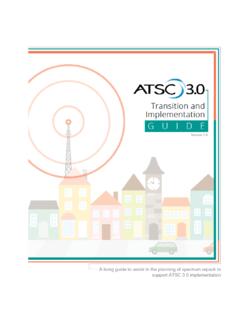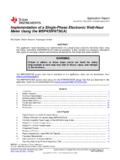Transcription of Implementation of FSK Modulation and …
1 Application Report SLAA618 November 2013. Implementation of FSK Modulation and demodulation using cd74hc4046a . Mahendra Patel .. Standard Linear and Logic ABSTRACT. In telecommunications and signal processing, frequency Modulation (FM) is encoding of information on a carrier wave by varying the instantaneous frequency of the wave. Digital data can be encoded and transmitted via carrier wave by shifting the carrier's frequency among a predefined set of frequencies a technique known as frequency-shift keying (FSK). FSK is widely used in modems, radio-teletype and fax modems, and can also be used to send Morse code. Frequency-shift keying (FSK) is a frequency Modulation scheme in which digital information is transmitted through discrete frequency changes of a carrier wave. This application report discusses logic- level Implementation of binary FSK (BFSK) modulator and demodulator using a phase-locked loop PLL.
2 Device CD54HC4046A, CD54 HCT4046A, cd74hc4046a , and CD74 HCT4046A (hereafter in this document referred to as HC/HCT4046A). BFSK is the simplest FSK, using a pair of discrete frequencies to transmit binary information. spacer Contents 1 Introduction .. 2. 2 Implementation of Modulator .. 3. 3 Implementation of Demodulator .. 5. 4 Test Circuit Waveforms .. 6. 5 Schemes To Realize Modulator Demodulator Pair .. 10. 6 Conclusion .. 12. List of Figures 1 Block Diagram of HC/HCT4046A in a Typical PLL Circuit .. 2. 2 Basic Block Diagram of a PLL as a Modulator .. 3. 3 Frequency Characteristics of VCO Operating without Offset .. 3. 4 Typical Modulator Schematic .. 4. 5 Basic Block Diagram of PLL as Demodulator .. 5. 6 Typical Demodulator Schematic .. 6. 7 Scheme 1 .. 10. 8 Scheme 2 .. 11. 9 Level-Shifter Circuit using LP211 .. 11. 10 Simulated Waveforms of Level-Shifter Circuit using LP211.
3 11. List of Tables 1 Modulator Test Circuit Results .. 4. 2 Demodulator Test Circuit Results .. 6. 3 .. Variation in VCOOUT Frequency, Peak-to-Peak Voltage and DEMOUT 7. 4 VCOIN (Modulating), VCOOUT (Modulated) and DEMOUT (Demodulated) .. 8. SLAA618 November 2013 Implementation of FSK Modulation and demodulation using 1. Submit Documentation Feedback CD54/74HC/HCT4046A. Copyright 2013, Texas Instruments Incorporated Introduction 1 Introduction Many measurement applications (for example, electric and gas meters) require a way to communicate electronically with a central office so that measured data can be reported back to the central office and new tariffs can be set in the remote site. (1) Telephony provides a convenient means of data communication. This application report discusses logic-level Implementation of FSK modulator and demodulator using a PLL device HC/HCT4046A.
4 The HC/HCT4046A, PLL with VCO is a high-speed CMOS IC designed for use in general-purpose PLL applications, including frequency Modulation , demodulation , discrimination, synthesis, and multiplication. Figure 1 illustrates the functional block diagram of a PLL IC, highlighting the following: The voltage controlled oscillator (VCO) generates a center frequency locally. The center frequency is compared with the incoming signal frequency using a phase comparator (PC). The PC generates an error voltage, Vd, which is fed into VCO after a low-pass filter (LPF) shifting the frequency of VCO to lock with the incoming signal. dTi SIGIN. Fi dt (EXT. REF.) Vd K d (Ti -To ). COMPIN PC. FILTER. F(s). dTo FOSC K o VC. dt VCOOUT. VCO. VCOIN. C1. VC. DEMOUT. R2 R1. Figure 1. Block Diagram of HC/HCT4046A in a Typical PLL Circuit spacer spacer spacer spacer spacer spacer spacer spacer spacer spacer spacer spacer spacer (1).
5 Schematics in this report are only for reference. Precise Implementation can vary from country to country and based on the application, transmission media, and so forth. 2 Implementation of FSK Modulation and demodulation using SLAA618 November 2013. CD54/74HC/HCT4046A Submit Documentation Feedback Copyright 2013, Texas Instruments Incorporated Implementation of Modulator 2 Implementation of Modulator The modulator uses only VCO, as shown in the block diagram illustrated in Figure 2. Values of R1 and C1. determine the frequency range of the VCO and center frequency of operation depends upon VCO input, which is a digital input signal level for a modulator. Hence high (bit1) and low (bit 0) voltage levels of digital input determines actual output frequencies and separation between them. Modulated Signal Center Frequency (R1, C1). VCO PC. Offset (R2). Buffer Modulator Digital Signal (to be Modulated).
6 Figure 2. Basic Block Diagram of a PLL as a Modulator To design a modulator with maximum and minimum frequency of fMAX and fMIN respectively, the following steps are required: 1. Given fMAX and fMIN, center frequency fO can be estimated as (fMAX fMIN) / 2, see Figure 3. fMAX. fVCO fo 2fL. fMIN. MIN 1/2 VCC MAX. VVCOIN. 2fL = Frequency Lock Range, fo= Center Frequency Figure 3. Frequency Characteristics of VCO Operating without Offset 2. Determine the values of R1 and C1 using figures 11 15 in the device datasheet (SCHS204). Note that the values of these components must satisfy following conditions: (a) 3 k < R1 < 300 k . (b) C1 > 40 pF. (c) (R1 || R2) > k . Use of R2 to set the offset frequency is optional and can be left open, if not needed. 3. Figure 16 21 of the device datasheet (SCHS204) gives an estimate of separation between frequencies for the given VCOIN voltage.
7 V < VCOIN < VCC is recommended to generate proper oscillation from VCO. SLAA618 November 2013 Implementation of FSK Modulation and demodulation using 3. Submit Documentation Feedback CD54/74HC/HCT4046A. Copyright 2013, Texas Instruments Incorporated Implementation of Modulator 4. An optional LPF (R3-C2, illustrated in Figure 4) is included to minimize noise at the VCOIN pin. The 3- dB cut off frequency of this filter should be 10 times or higher than the maximum bit rate of the modulating signal. VCC_5V. U1. 1 16 VCC. 2 PCP out VCC 15. cd74hc4046a . TP2 1 2 3 PC1out PC3out 14. 4 COMPin SIGin 13. VCC JP4 1 2 R4 10k 5 VCOout PC2out 12 R2. 6 INH R2 11 R1. JP3 1 2 7 C1A R1 10. C1 8 C1B DEMout 9 R3. GND VCOin 2. C2 TP1. 1. Figure 4. Typical Modulator Schematic Example: A test circuit (VCC = 5 V) was implemented to modulate a digital signal with the following component values: R1 = 3 k , C1 = 47 pF, R2 = open, R3 = 0 , C2 = open Table 1.
8 Modulator Test Circuit Results VCOIN (V) Frequency of VCOOUT (Hz) VCOOUT peak to peak (V). 1. M 2. M 3. M Therefore, by choosing logic 0 as 1 V and logic 1 as V, a frequency separation of MHz can be obtained. In a practical circuit, frequency separation depends upon the bandwidth availability of the transmission media. Therefore, by choosing an appropriate offset frequency and voltage level of the VCOIN signal, expected Modulation can be achieved. 4 Implementation of FSK Modulation and demodulation using SLAA618 November 2013. CD54/74HC/HCT4046A Submit Documentation Feedback Copyright 2013, Texas Instruments Incorporated Implementation of Demodulator With an increase in VCOIN (CH1) voltage, the frequency of oscillation increases and VCOOUT peak-to-peak voltage (CH2) decreases as shown in Waveform 1. Waveform 1. VCOIN (CH1) Voltage and VCOOUT Peak-to-Peak (CH2) Variation 3 Implementation of Demodulator The demodulator operates in closed-loop mode with the PC and an external LPF, as shown in Figure 5.
9 Modulated Signal Center Frequency (R1, C1) LPF. VCO PC. Offset (R2) (R3, C2). Demodulated Signal Buffer Demodulator Figure 5. Basic Block Diagram of PLL as Demodulator To design a demodulator with maximum and minimum frequency of fMAX and fMIN, respectively (which is same as that of modulator), the following steps are required: 1. Use the same value of R1 and C1 as that of modulator. 2. While using PC1, the capture range depends on the LPF (R3-C2) characteristics and can be made as large as the lock range. For PC2, capture range is equal to lock range and is independent of the LPF. 3. Since leakage current can affect the VDEMOUT, a load resistor (R5) from this pin to GND in the range of 50 k to 300 k is recommended. SLAA618 November 2013 Implementation of FSK Modulation and demodulation using 5. Submit Documentation Feedback CD54/74HC/HCT4046A. Copyright 2013, Texas Instruments Incorporated Test Circuit Waveforms A typical demodulator schematic is illustrated in Figure 6.
10 VCC_5V. U1. 1 16 VCC. 2 PCP out VCC 15. cd74hc4046a . 1 2 JP2 3 PC1out PC3out 14 1 2 TP1. 4 COMPin SIGin 13. JP4 1 2 R4 10k 5 VCOout PC2out 12 R2. 6 INH R2 11 R1. JP3 1 2 7 C1A R1 10 1 2 TP2. C1 8 C1B DEMout 9. VCC GND VCOin R5 50k R3 JP1. 1 6. C2 2 5. 3 4. Figure 6. Typical Demodulator Schematic Example: A test circuit (VCC = 5 V) was implemented to demodulate a digital signal using PC2 with following component values: R1 = 3 k , C1 = 47 pF, R2 = open, R3 = 36 k , C2 = 120 pF. Table 2. Demodulator Test Circuit Results VCOIN (V) at Frequency of SIGIN (Hz) at SIGIN peak to peak (V) at DEMOUT (V) at modulator Modulator Demodulator demodulator 1. 2. 3. Therefore, by choosing Vp-p VCOIN and frequency separation of MHz at modulator, DEMOUT of ( ) = Vp-p can be obtained. 4 Test Circuit Waveforms The waveforms in Table 3 show variations in the following when VCOIN voltage is changed: (a) VCOOUT frequency (b) Peak-to-peak voltage of modulator VCOOUT or SIGIN of demodulator (c) Corresponding DEMOUT voltage The waveforms in Table 4 show VCOIN (level-shifted digital modulating signal), VCOOUT (modulated signal).














